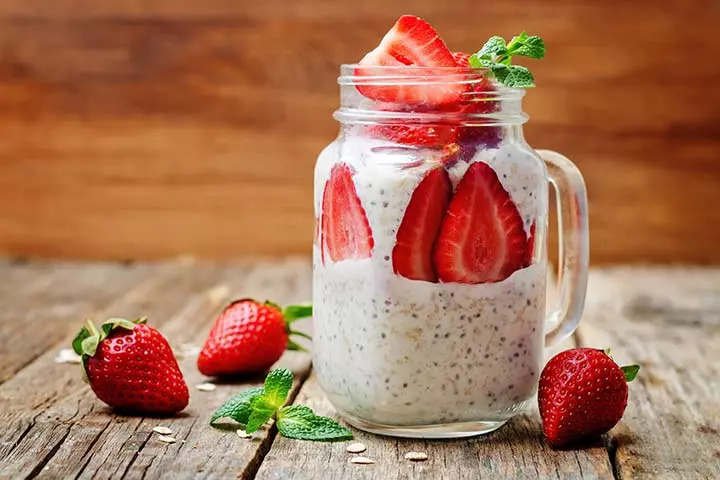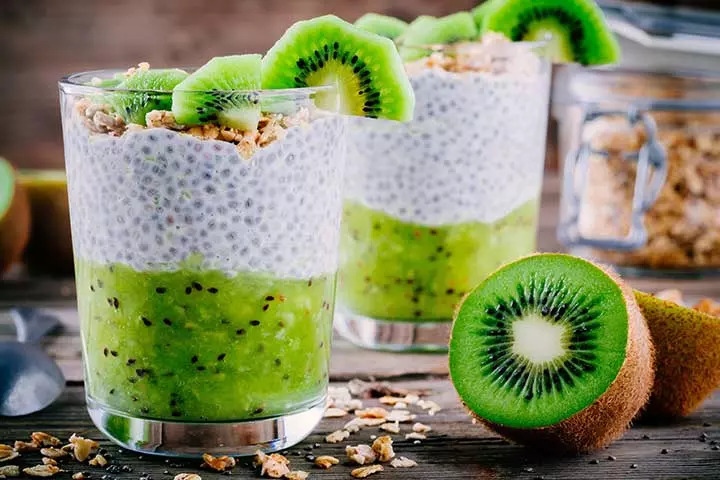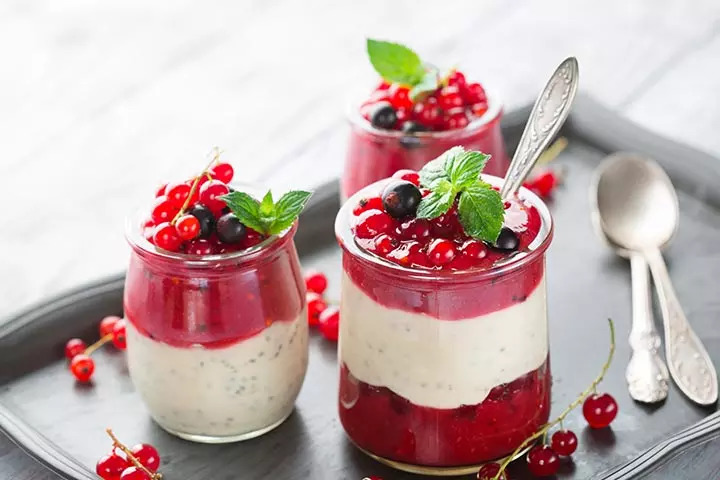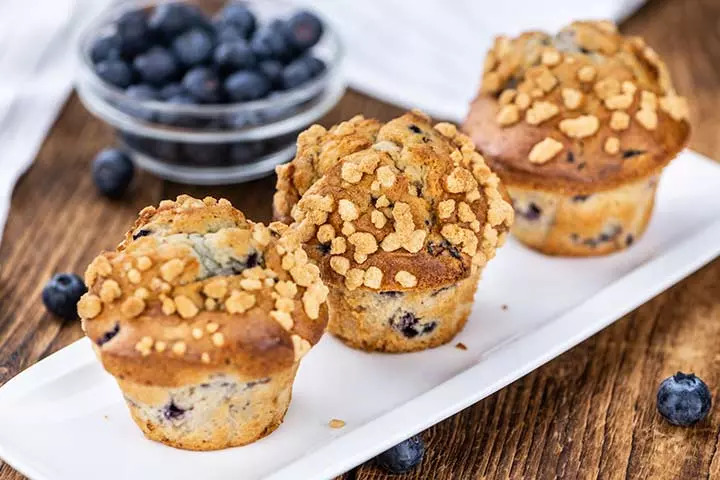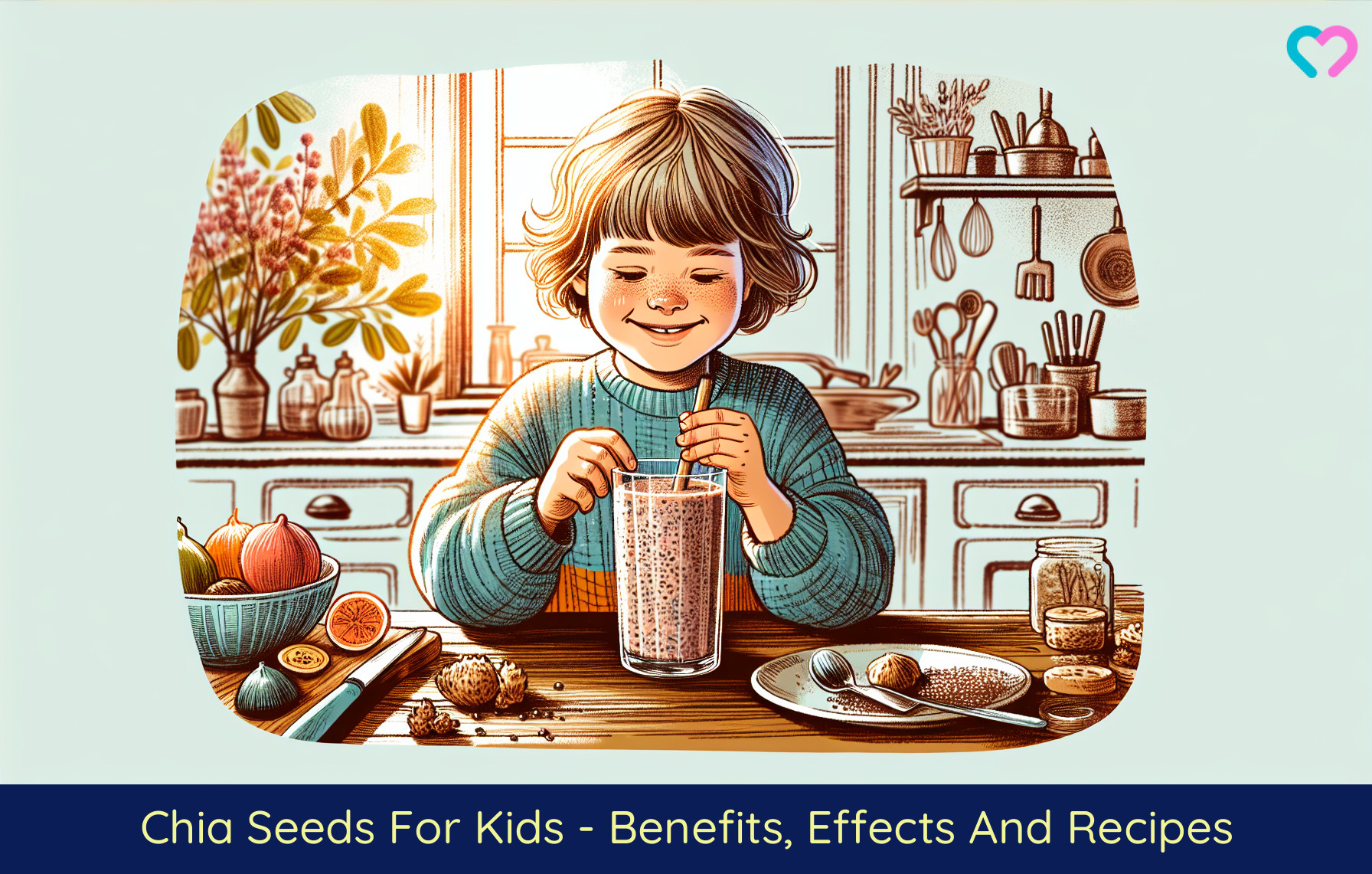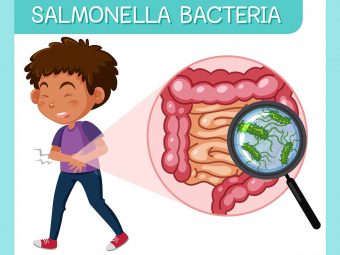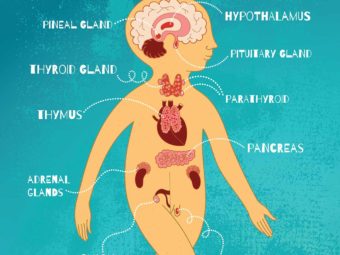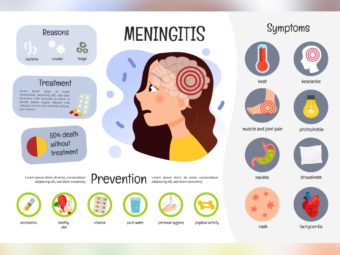
Chia seeds are nutritious, edible, black, brown, or white-colored seeds that belong to the plant of the same name (Chia). Many parents consider serving chia seeds for children owing to their alleged medicinal and health benefits. In addition, they are rich sources of fiber, possess several micronutrients, and can be included in various dishes that could be served to children.
Read on to explore more details about chia seeds, their potential health benefits, and some innovative ways to include them in healthy drinks, snacks, or meals for children and teens.
Can Children Consume Chia Seeds?
Yes, children and teens can consume chia seeds as a part of a balanced diet. The US Food and Drug Administration (USFDA) categorizes chia seeds as (GRAS) ‘generally recognized as safe’ (1). They are so bland that you can add chia seeds to different sweet or savory meals and beverages to enhance the overall nutritional value of your child’s meal.
Chia seeds should be eaten only after being soaked in water, milk, or any other food with a semi-liquid consistency, like yogurt. Eating dry or inadequately soaked chia seeds may increase the risk of gastrointestinal blockage (2). When soaked, chia seeds absorb liquid and develop a gelatinous consistency, making them easy to swallow and digest.
 Did you know?
Did you know?How Much Chia Seeds Can Children Consume?
There is no recommended daily limit of chia seeds for children and teens. You may add a teaspoon of soaked chia seeds a day to food items and serve it to your child. If your child is not used to eating much fiber, then you add them in slowly and increase gradually. If you want to know the safe limit of chia seeds for your child, consult a pediatric nutritionist or a pediatrician.
Pediatrician Dr. Bidisha Sarkar says, “Chia seeds are rich in omega-3 fatty acids, fiber, protein, and various micronutrients. They are a wholesome addition to a child’s diet, and it’s safe for children to consume them daily as part of a balanced diet. However, because of their high fiber content, it’s crucial to begin with a small amount and gradually increase it to prevent digestive discomfort.”
Possible Health Benefits Of Chia Seeds
An ounce (28g) of chia seeds provides only 137 calories, 4.69g of protein, 9.75g of fiber, 179g calcium magnesium, manganese, phosphorus, zinc, vitamin B 3, B1, B2, and other essential nutrients, 9g of fats out of which 5g are omega-3 and also contains omega-6 fatty acids, and polyphenols (3) (4). Not only this but chia is naturally gluten-free as well. These nutritional compounds may provide the following health benefits in the long run.
- Provides complete protein for growth: This superfood contains all the essential nine amino acids making them a source of complete protein (whole protein) (2). Proteins are the building blocks essential for the growth and development of children and adolescents (2).
- Contains minerals for bone health: Chia seeds provide minerals, such as calcium, magnesium, and phosphorus, that could help maintain healthy bones in children and teens.
- Benefits overall health: Omega-3 fatty acids found in chia seeds could improve cardiovascular health and the circulatory system’s health. These fatty acids are even good for the nervous system and the eyes (5). Chia seeds also contain omega-6 fatty acids that could promote overall health in the long run (6).
 Quick fact
Quick fact- Dietary fiber benefits the digestive system: Chia seeds contain soluble fiber that brings satiety, prevents overeating, and benefits the overall digestive system (2). In the long run, dietary fiber may help keep LDL cholesterol and blood sugar levels under check.
- Offer antioxidants for long-term health: Chia seeds contain several antioxidant compounds, such as carotenoids and polyphenolic compounds (7). Regular consumption of antioxidants promotes overall health in the long run and may reduce the risk of chronic diseases.
Apart from the above benefits, chia seeds have shown to possess anti-inflammatory, antimicrobial, and antidepressant properties in some studies (7) (8).
Possible Side Effects Of Chia Seeds
Chia seeds seldom cause any side effects when consumed in a small quantity as part of a balanced diet. Excess consumption and eating chia seeds in a few cases may cause the following side effects.
- Eating too many chia seeds may cause gastrointestinal issues, like bloating, gas, and abdominal pain diarrhea, and constipation due to high fiber intake (9).
- Chia seeds swell up in size by absorbing water. Drinking water after ingesting unsoaked, raw chia seeds may lead to obstruction in the digestive tract (2). Therefore, it is advised to consume soaked chia seeds only.
- Individuals with gastrointestinal issues, like irritable bowel syndrome or diverticulitis, may experience abdominal discomfort after consuming chia seeds. Consult a doctor before consuming chia seeds if you are dealing with gastric problems.
- Chia seeds allergy and cross-reactivity are rare but possible (10). Chia seeds have shown cross-reactivity to sesame seeds (11) (12), suggesting that individuals with sesame seeds allergy avoid chia seeds.
- Children with difficulty in swallowing may have to exercise extra care while eating chia seeds.
Chia seeds, when consumed appropriately, can be beneficial to health. Below are some tasty chia seeds recipes that are worth trying.
Delicious Chia Seeds Recipes For Children And Teens
These nutritionally sumptuous and tasty chia seeds recipes can be enjoyed by children and teens. These recipes are also easy-to-prepare and ideal for refueling children’s energy levels between playtimes.
1. Overnight oats with chia seeds
You will need:
- 1 cup rolled oats
- 1 cup unsweetened almond milk or whole milk
- 1 cup chopped fruits (banana, mango, papaya)
- 1 cup fresh strawberries (sliced)
- 1tbsp chia seeds
- 3tbsp mixed nuts (walnuts, almonds, and pistachio)
- 1tsp Manuka honey
- ½ tsp cinnamon powder
How to:
- Put all the ingredients except strawberry slices in a mason jar and store it in the refrigerator overnight.
- The next day, garnish with strawberry slices and serve right away.
 Quick fact
Quick fact2. Kiwi chia smoothie
You will need:
- 1 cup kiwi (peeled and diced)
- ½ cup almond milk or skimmed milk
- ½ cup plain Greek yogurt
- 1tbsp chia seeds
- 2tbsp crushed mixed nuts (hazelnut and macadamia nuts)
- ¼ tsp unsweetened cocoa powder
How to:
- Blend all the ingredients into a smooth-flowing liquid.
- Pour the smoothie into a serving glass, store in a refrigerator, and serve chilled after 15 minutes.
- You can pour the smoothie into a bowl and refrigerate it for an hour to make chia pudding.
- You can garnish with kiwi chunks and nuts.
3. Strawberry and chia seed parfait
You will need:
- 1 cup strawberries (finely chopped)
- ½ cup graham cracker crumbs
- 1 cup plain Greek yogurt or plain yogurt
- ½ cup dried fruits (figs and dates, chopped)
- 1tbsp chia seeds
- ½tsp cinnamon powder
How to:
- In a mixing bowl, add Greek yogurt with dried fruits, strawberry, chia seeds, and cinnamon powder, and mix thoroughly.
- Take a parfait glass and add a tablespoon of graham cracker crumbs in it. Then, top the layer with strawberry and Greek yogurt mix.
- Alternate between cracker crumbs and yogurt mix until the parfait glass fills almost an inch less than the brim.
- Serve right away or cover with plastic wrap and chill in the refrigerator for ten minutes before serving. You can top it up with leftover crackers and fruit pieces.
4. Blueberry and chia seeds muffin
You will need:
- 1 cup rolled oats
- 1 cup all-purpose flour
- 2 large eggs (beaten)
- 2 cups blueberries
- 1 cup orange juice
- ½ cup applesauce
- ½ cup chia seeds
- 1 cup brown sugar
- 2.5tsps baking powder
- 1tsp salt
- ½ tsp baking soda
- 2tbsps brown sugar
- ¼ tsp ground cinnamon
- ½ cup coconut cooking oil
How to:
- Preheat the oven to 375°F (190°C) and line a muffin tray with paper liners.
- Sift all-purpose flour, sugar, baking powder, salt, and baking soda in a large bowl and add oats and chia seeds.
- Mix orange juice, applesauce, eggs, and oil into the bowl and mix everything to form a smooth batter.
- Add blueberries to the batter and fill three fourth of each muffin cup in the tray.
- Sprinkle cinnamon powder and some sugar over the muffins and bake the muffins for 20 minutes or until the muffins rise and look dark brown. You can insert a toothpick in the center of a muffin, if it comes out clean, then it’s done.
- You can serve chia seeds muffins for breakfast with a cup of milk or pack as a school snack.
5. Creamy coconut chia soup
You will need:
- 2 cups baby carrots (quartered lengthwise)
- 2.5 cups low-sodium vegetable broth
- 2 cups fresh cilantro sprigs
- 1/4 cup chia seeds
- 1 cup coconut milk
- 1 onion (chopped)
- ¾ tsp sea salt
- 2tsps fresh ginger (peeled and grated)
- 2tsps Thai yellow or red curry paste
- 1 clove garlic (peeled and chopped)
- 2tbsps fresh lime juice
How to:
- Pour one-third cup of the coconut milk in a stockpot and heat it in on medium heat.
- Add onion and salt, and cook while stirring continuously for about five minutes.
- Add ginger, curry paste, and garlic and cook everything together for an additional one minute.
- Add the carrots, broth, lime juice, cilantro, and the remaining coconut milk in the stockpot and bring the mix to a boil over high heat.
- Reduce the heat to low, and let the mixture simmer in the covered pot for 30 minutes.
- After 30 minutes, turn off the heat, and remove the cilantro sprigs from the pot.
- Puree the mixture into a thick soup using an immersion blender.
- Transfer the soup to a saucepan and place it over low heat.
- Add chia seeds and let the soup simmer for about 20 minutes or until the chia seeds swell up, are fully hydrated and the soup looks thick or reaches the desired consistency.
- There you have a warm vegan soup bowl ready to relish. Pour the soup into a serving bowl, garnish with some chia seeds and small cilantro sprigs, and serve immediately with toasted garlic bread or breadsticks.
6. Chocolate chia pudding
Image: Shutterstock
You will need:
- 2tbsp cacao powder
- 2tbsp maple syrup
- 1tsp vanilla extract
- 1 cup milk
- ¼ cup chia seeds
- Raspberries
- Chocolate shavings
- Nuts and seeds
How to:
- Mix cacao powder, maple syrup, vanilla, dairy-free milk, and chia seeds in a bowl. Whisk everything together.
- Let it sit for 15 minutes for chia seeds to gel. After 15 minutes, whisk again and cover the bowl.
- Refrigerate overnight or at least 4 hours for the best consistency.
- Take out the chocolate chia pudding and stir gently with a spoon.
- Spoon it into dessert glasses and top with raspberries, chocolate savings, or nuts and seeds.
Frequently Asked Questions
1. At what age can children try chia seeds?
You can offer chia seeds to children once they have been introduced to most solid foods. First, start feeding chia seeds to children in soaked form. After their first intake of chia seeds, you may follow the three/five-day rule to observe if your child is tolerant of them.
2. How to make chia seeds fun for kids?
Adding fruits, yogurt, chocolate, and nuts is an interesting way to serve chia seeds to children. If your child does not enjoy muesli recipes, you can always add chia seeds to their favorite homemade cold beverages. You can also add chia seeds to their smoothies, granola bars, cookies, lemonade, or meatloaves.
Wendy, a mother of four, shares quick and delightful ways to add chia seeds to beverages. She says, “The original recipe I’d read was a spoonful of sugar (I used honey instead) and a spoonful of chia seeds in a glass of water with a squeeze of lime juice. But it’s much prettier, tastier, and healthier, with a bit of pomegranate juice added in. The kids drink it despite, or possibly because of, the fact that chia seeds start to resemble gelatinous little fish eggs when soaked. This morning, I also tried mixing a spoonful with some freshly made almond milk and a bit of honey, and the kids loved it that way too (i).”
3. Are chia seeds good for the skin?
Yes, chia seeds are good for the skin. They are rich sources of vitamins A, B, E, K, and D. Also, they are high in omega-3-fatty acids, all of which help promote healthy skin (7).
4. Can chia seeds cause kidney stones?
One case study suggested that excess consumption of chia seeds could increase the oxalate levels in the body, leading to the formation of kidney stones. However, there are limited studies on this topic, and the formation of kidney stones is a likely complication followed by excessive consumption. Hence, when taken in recommended amounts, chia seeds are safe for health (13).
5. Is there any difference between white and black chia seeds?
No, there is no difference between white and black chia seeds in terms of nutritional content or taste. The only difference is their appearance due to the variety of chia plants that produce the seeds.
6. How do you store chia seeds?
It is advisable to store chia seeds in a glass container in the refrigerator for a longer shelf life.
Chia seeds for kids could be a nutrient-rich addition to their diet. Since these seeds are bland in taste, you may add them to various preparations such as soups, curries, smoothies, and puddings. Also, you could sprinkle these seeds on salads or mix them in the yogurt to serve your child. However, remember to soak chia seeds before consumption to enable proper digestion. Chia seeds offer significant health benefits and have antimicrobial properties that help promote overall health and immunity in children. So, include these tiny healthful seeds to your child’s meal to add variety and nourishment to their meal.
Infographic: Some More Delicious Chia Seeds Recipes For Children
Children are picky about what they eat. But being a parent, you always look for ways to sneak in healthy ingredients. Chia seeds are an ingredient you may want to include in your child’s diet. Let’s go through the infographic below to learn some recipes for chia seeds preparations that are delicious and healthy for your children. Illustration: Momjunction Design Team
Key Pointers
- The US Food and Drug Administration has categorized chia seeds as ‘generally safe to eat.’
- Eating dry chia seeds may lead to digestive issues.
- Chia seeds are considered a ‘whole protein’ and contain minerals, fiber, and healthy fats.
- Chia seeds help with better bone, digestive, and overall health.
- People with gastrointestinal problems or seed allergies should consult a doctor before consuming chia seeds.
Image: Dall·E/MomJunction Design Team
Master the art of preparing five mouthwatering and health-conscious chia pudding variations swiftly, thanks to this video. From timeless vanilla to exotic mango, satiate your cravings effortlessly.
Personal Experience: Source
MomJunction articles include first-hand experiences to provide you with better insights through real-life narratives. Here are the sources of personal accounts referenced in this article.
i. Chia drink;https://wisdomofthemoon.blogspot.com/2010/06/chia-drink.html
References
1. Food as Medicine Update: Chia (Salvia hispanica, Lamiaceae); American Botanical Council
2. Chia Seeds; Harvard T.H. Chan
3. Seeds, chia seeds, dried, FDC ID: 170554; Food Data Central; USDA
4. Bartosz Kulczyński et al.; The Chemical Composition and Nutritional Value of Chia Seeds—Current State of Knowledge; NCBI
5. Do Kids Need Omega 3 Fats; EatRight; Academy of Nutrition And Dietetics
6. Healthy food trends — chia seeds; Medline Plus; U.S. National Library of Medicine
7. Masa Knez Hrncic et al.; Chia Seeds (Salvia Hispanica L.): An Overview—Phytochemical Profile, Isolation Methods, and Application; MDPI
8. Rahman Ullah, M. Nadeem et al.; Nutritional and therapeutic perspectives of Chia (Salvia hispanica L.): a review; NCBI
9. Fiber; Oregon State University
10. Tomas-Pérez M et al.; Dermatitis Caused by Ingestion of Chia Seeds; Journal of Investigational Allergology and Clinical Immunology
11. Ben Abdulrahman Albunni et al.; Antibody Cross-Reactivity between Proteins of Chia Seed ( Salvia hispanica L.) and Other Food Allergens; NCBI
12. Emerging allergens; Anaphylaxis Campaign
13. Garland V et al; Diet-induced oxalate nephropathy from excessive nut and seed consumption; NCBI





